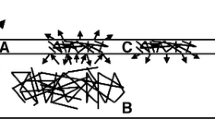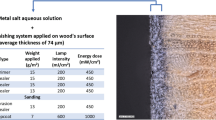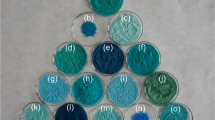Abstract
In the past, the practice of dyeing wood was very widespread, for instance for obtaining substitutes for rare and expensive ebony, which was used for all marquetry techniques and especially for making inlays to decorate musical instruments. This study focuses on two traditional wood-dyeing procedures carried out with iron–gall dye and iron–logwood dye, respectively. In order to reproduce the ancient techniques, preparation of dyes and their application on two different wood species (poplar and pear) were carried out according to typical ancient recipes and traditions. Wood samples were dyed using mixtures similar to two of the most important historic iron inks, and several specimens (approximately 7 mm in size) were taken and investigated in order to: (1) gain a better insight into the processes involving the dyes and the wood matrices, (2) analyze the effects of the treatments on the anatomical wood structures, (3) evaluate the level of penetration of the dyestuffs into the samples. The analyses were performed after each step of the dyeing procedures, both on the wood samples and on the solutions. Various reaction processes were hypothesized after a micro-Fourier transform infrared spectroscopy analysis, performed in transflection and attenuated total reflection mode. The effects of the various treatments on the wood samples were studied by means of stereomicroscopy, polarized optical microscopy and scanning electron microscopy coupled with energy-dispersive X-ray spectroscopy. The results obtained suggested that both treatments cause alterations in the outer 300 µm of the wooden samples, and that a higher level of penetration was obtained with the hematein complex than with the iron-gall ink.






Similar content being viewed by others
References
Bicchieri M, Monti M, Piantanida G, Sodo A (2008) All that is iron-ink is not always iron-gall! J Raman Spectrosc 39:1074–1078
Bonizzoni L, Canevari C, Galli A, Gargano M, Ludwig N, Malagodi M, Rovetta T (2014) A multidisciplinary materials characterization of a Joannes Marcus viol (16th century). Herit Sci 2:15
Cardon D (2003) Le Monde des Teintures Naturelles. Belin, Paris
Cardon D (2007) Natural dyes: sources, tradition, technology and science. Archetype Books, London
Centeno SA, Ropret P, Del Federico E, Shamir J, Itin B, Jerschow A (2010) Characterization of Al(III) complexes with hematein in artistic alum logwood inks. J Raman Spectrosc 41:445–451
Chen H, Ferrari C, Angiuli M, Yao J, Raspi C, Bramanti E (2010) Qualitative and quantitative analysis of wood samples by Fourier transform infrared spectroscopy and multivariate analysis. Carbohydr Polym 82:772–778
Ciglanská M, Čeppan M (2012) Viscometry determination of the kinetic of degradation of iron-gall inks. Acta Chim Slov 5:126–130
Ferreira ESB, Hulme AN, McNab H, Quye A (2004) The natural constituents of historical textile dyes. Chem Soc Rev 33:329–336
Hahn O, Malzer W, Kanngiesser B, Beckhoff B (2004) Characterization of iron-gall inks in historical manuscripts and music compositions using X-ray fluorescence spectrometry. X-Ray Spectrom 33:234–239
Huang Y, Wang L, Chao Y, Nawawi DS, Akiyama T, Yokoyama T, Matsumoto Y (2012) Analysis of lignin aromatic structure in wood based on the IR spectrum. J Wood Chem Technol 32:294–303
Kanngieger B, Hahn O, Wilke M, Nekat B, Malzer W, Erko A (2004) Investigation of oxidation and migration processes of inorganic compounds in ink-corroded manuscripts. Spectrochim Acta B 59:1511–1516
Kolar J, Stolfa A, Strliˇ M, Pompe M, Pihlar B, Budnar M, Simˇciˇc J, Reissland B (2006) Historical iron gall ink containing documents—properties affecting their condition. Anal Chim Acta 555:167–174
Krekel C (1999) The chemistry of historical iron-gall inks: understanding the chemistry of writing inks used to prepare historical documents. Int J Forensic Doc Exam 5:54–58
Malagodi M, Canevari C, Bonizzoni L, Galli A, Maspero F, Martini M (2013) A multi-technique chemical characterization of a Stradivari decorated violin top plate. Appl Phys A 112:225–234
Melo MJ, Claro A (2010) Bright light: microspectrofluorimetry for the characterization of lake pigments and dyes in works of art. Acc Chem Res 43:857–866
Mohammed-Ziegler I, Billes F (2002) Vibrational spectroscopic calculations on pyrogallol and gallic acid. J Mol Struct 618:259–265
Pandey KKA (1999) Study of chemical structure of soft and hardwood and wood polymers by FTIR spectroscopy. J Appl Polym Sci 71:1969–1975
Pantoja-Castroa MA, Gonzalez-Rodrıguez H (2011) Study by infrared spectroscopy and thermogravimetric analysis of tannins and tannic acid. Rev Latinoam Quım 39:107–112
Puchtler H, Meloan SN, Waldrop FS (1986) Application of current chemical concepts to metal-hematein and brazilein stains. Histochemistry 85:353–364
Rosenberg E (2008) Characterization of historical organic dyestuffs by liquid chromatography–mass spectrometry. Anal Bioanal Chem 391:33–57
Roth KT (2007) How to inlay purfling: the delicate process of adding inlaid decoration. The Strad 118, London, pp 70–73
Senvaitiene J, Beganskiene A, Kareiva A (2005) Spectroscopic evaluation and characterization of different historical writing inks. Vib Spectrosc 37:61–67
Shirai K, Matsuoka M (1996) Structure and properties of hematein derivatives. Dyes Pigments 32:159–169
Sokolová R, Degano I, Hromadová M, Bulíkov J, Gál M, Valášek M (2010) Oxidation pathways of natural dye hematoxylin in aqueous solution. Collect Czech Chem Commun 75:1097–1114
Svobodova E, Bosakova Z, Ohlidalova M, Novotna M, Nemec I (2012) The use of infrared and Raman microspectroscopy for identification of selected red organic dyes in model colour layers of works of art. Vib Spectrosc 63:380–389
Turco A (1982) Coloritura verniciatura e laccatura del legno. Hoepli, Milano
Zadro MG (1975) Woods used for woodwind since the 16th century: a descriptive dictionary of the principal woods mentioned source. Early Music 3:249–251
Author information
Authors and Affiliations
Corresponding author
Rights and permissions
About this article
Cite this article
Canevari, C., Delorenzi, M., Invernizzi, C. et al. Chemical characterization of wood samples colored with iron inks: insights into the ancient techniques of wood coloring. Wood Sci Technol 50, 1057–1070 (2016). https://doi.org/10.1007/s00226-016-0832-2
Received:
Published:
Issue Date:
DOI: https://doi.org/10.1007/s00226-016-0832-2




